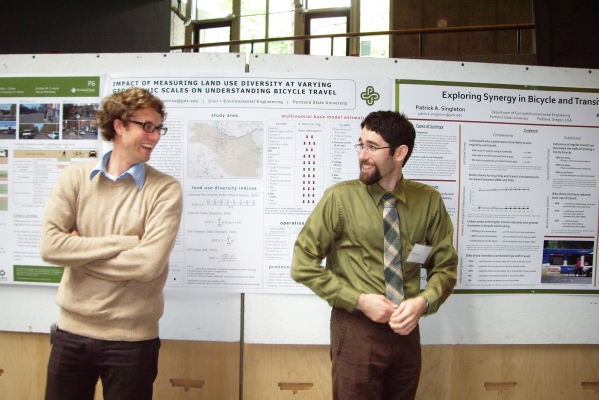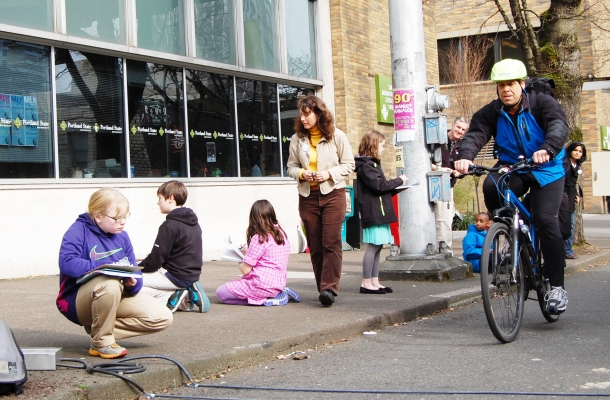Portland, Oregon is known for being a bike city, even called America's Best Bike City by Bicycling Magazine, so it's no surprise at all that Portland State University is full of bike enthusiasts.
Calvin Tribby, a Ph.D. candidate at the University of Utah, was recently awarded one of NITC's 2013 dissertation fellowships.
Five OTREC-supported student transportation researchers presented their work Wednesday at Portland State University's first Student Reserach Symposium. Tara Goddard and Katherine Bell presented their work in panel sessions, while Sam Thompson, Patrick Singleton and Oliver Smith presented posters.
Goddard presented her paper, "Are Bicycling and Walking 'Cool'?: Adolescent Attitutes About Active Travel," in the public health and urban studies session. She'll offer an in-depth take on the same topic at noon May 24 for OTREC's Friday transportation seminar. Click here for more information.
Bell's paper, "Evaluation of Smart Phone Weight-Mile Truck Data for Supporting Freight Modeling, Performance Measures and Planning," details some of her work with civil engineering associate professor Miguel Figliozzi. Click here to download a version of the paper.
Thompson's poster was "A Study of Bicycle-Signal Compliance Employing Video Footage;" Singleton's poster was "A Theory of Travel Decision-Making: Applications for Active Travel;" Smith's was "The Effects of Mode Choice on Subjective Well-Being: Evidence from Portland, Oregon."
The...
Read moreOTREC turned its education efforts on a decidedly younger crowd March 13: sixth graders. A class from Rochester, N.Y., visited Portland on a trip geared toward improving bicycling in their own community.
The students, from Genesee Community Charter School, visited the OTREC offices to learn about active transportation research methods. They took part in group exercises designed to get them thinking about the planning and engineering challenges of transportation systems set up to serve multiple transportation modes.
The highlight of the day came when the students took to Portland’s streets — OTREC’s living laboratory — to conduct research of their own. Armed with bicycle-counter tubes and infrared detectors, students counted cyclists and pedestrians passing on the Broadway cycle track on Portland State University’s campus.
Other students verified the technology with manual counters.
Students moved on to their next stop on a four-day tour of Portland with a better sense of what kind of data researchers collect and how they can use those data to inform policy. Given their experience — the students already have influenced their city on policy ranging from Erie Canal re-watering to an urban art corridor to skate parks — they stand a good chance of using Portland’s lessons to build a bike-friendly Rochester.
Tessa Walker, a Portland State University master's student in urban planning, has launched a national survey on skateboarding for transportation for her thesis resesarch. Walker sees skateboarding as a mostly unexplored corner of active transportation, with little information available to guide urban planners.
The study is open to people 18 and older in the U.S. and Canada who have skated as a way to get around within the last five years. Responses will be kept confidential and used for research purposes only.
To take the study or learn more, visit:
http://skatestudypdx.wordpress.com/
National Geographic recently described Portland as the City that “…gets almost everything right; it’s friendly, sustainable, accessible, and maybe a model for America’s future” (Cover story, Dec. 2009). Portland has a shared vision of a livable city, articulated in many different ways. It is seen in neighborhood self-help projects, big municipal investments, enlightened developers that build infill projects consistent with city plans, and the highest recycling participation rate in the country. Taken together Portland is a city that is environmentally responsible, and conscious of both street level and of global impact of doing things right.
Early History
Arguably, Portland’s first act of ‘building green’ was in 1892, when it built a reservoir network to protect and preserve the sole source of its drinking water, the pristine . Today, this 102-square mile conservation zone provides ample fresh water to a region of half million people
Fast forward almost 100 years and the same ethic motivated Portlanders to reject a Robert Moses-style highway plan...
Read more In the last of the livability seminar series, OTREC's visiting scholars program welcomed Shawn Turner from the Texas Transportation Institute. Shawn's research spans the gamut of intelligent transportation systems data to bicycle and pedestrian issues. Most recently, Shawn participated in the International Scan on Pedestrian and Bicyclist Safety and Mobility. His presentation compared his experiences on the scan in Europe to those in China. During his presentation, he posed three challenges to Oregon:
- How does active transportation contribute to economic development?
- What is the tipping point for behavior and behavioral change?
- Can vanity play a role in social acceptance?
His presentation was followed by a discussion with local agencies, faculty, students and partners along with a 10-mile tour of innovative bike infrastructure in Portland. Thank goodness...
Read moreWatch video
View slides
Summary: Researchers from the transportation, planning and health fields share the common goal of promoting physically active lifestyle. One challenge that researchers often face is the measurement of physical activity, particularly among children. This is because the sporadic nature of children’s physical activity patterns makes it difficult to recall and quantify such activities. Additionally, children’s lower cognitive functioning compared to adults prevents them from accurately recalling their activities. This presentation will describe the design and application of a novel self-report instrument - the Graphs for Recalling Activity Time (GReAT) - for measuring children’s activity time use patterns. The instrument was applied in a study of children’s risk for obesity and diabetes in a predominately Hispanic community in Milwaukee, WI. Time-use data for two weekdays and one weekend day were collected for various physical and sedentary activities. The data was then assessed against measurements of the children’s cardiovascular fitness, weight status and insulin resistance through exploratory analysis and structured equation modeling. Findings on GReAT’s reliability and new evidence on the impacts of time-use in different activities on children’s risk for...
Read more

